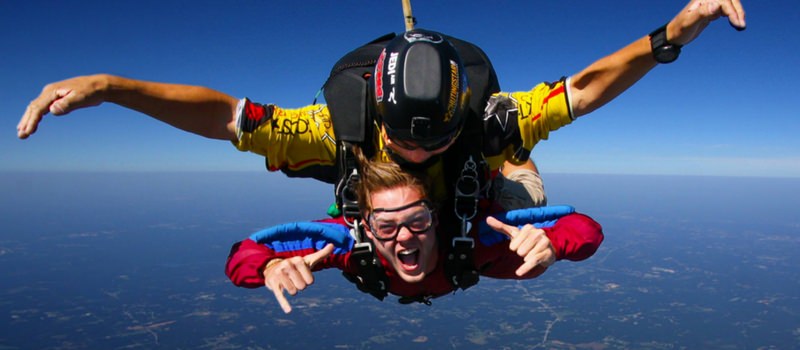There’s a classic post-jump expression that first-time tandem skydivers often wear. It looks like this: enormous grin; eyes enormously wide; face tipped up to look at the sky, as if they are something close to stunned by what they’ve just experienced. There’s also a distinct element of surprise to that expression.
We suspect that’s because they had some assumptive certainties about what their skydive was going to be like, and those assumptions have been smashed into a million pieces. Here’s what we imagine might be putting that whoa on their faces:
Skydiving Fact #1: You Don’t Feel Like You’re Falling.
When you’re first squaring up to the idea of a skydive, you’re likely pretty sure that it’s going to involve a falling feeling. After all: you know, in your body, what it feels like to fall, and when you jump into nothingness from the open door of an airplane, you’re going to be falling for quite a while. It stands to reason that you’d feel that fall, no?
Actually: Yeah, nope.
When you jump out of a plane, you’re not actually falling into nothingness. You’re falling into a whole lot of air molecules, and they work together to make you feel like you’re being held up. In the same way that your body would be pushed from the front if you stood in front of a fan blowing 120 miles per hour, your body will be held by the air in freefall. It’s a really nice feeling, actually–not like the “stomach drop” and the kicking and flailing you do as you make your way through, say, a bungee jump.

Skydiving Fact #2: You Don’t Feel Speed.
Kind of along those lines: you might think that your 120 mile-and-hour downward progress through the wild blue yonder is going to feel like you would if you zoomed 120 miles an hour down the freeway on a racing motorcycle. That’s not the case at all, which probably catches lots of new jumpers off guard. (It caught us off guard on our first jumps!)
The difference is perspective. When you’re on that motorcycle, you have lots of reference points all around you that your brain uses to gauge your speed and arrive at the conclusion holy schmoly I’m going fast maybe I should slow down a little bit or I’m gonna go to jail probably. In the sky, you don’t have those reference points. Even your videographer will be moving relative to you.
If you happen to pass a cloud, however–you’ll notice how fast you’re going. And that, trust us, is one heck of a rush. Whee!
Skydiving Fact #3: It Feels Like It’s Over So Quickly, But At The Same Time Every Moment Up There Feels Like A Hundred Years.
This little cognitive phenomenon is a fun one, and scientists are actively investigating where it comes from.
The actual timing is pretty standard across jumps: If you exit from 14,000 feet, from a plane moving at just over 100mph, falling at 120mph (which works out to a descent rate of about 10,000 feet every six seconds), with a parachute deployment at 5,500 feet, you can expect to be in the air for about six-or-so-minutes. Even so, with those facts clearly stated: Once you land, try to tell us how long everything took. Your brain will be waffling between two and fifteen minutes. It’s baffling and delightful.
Skydiving Fact #4: The Equipment Matters. Lots.
This seems like it should go without saying, but we’ll say it anyway: safe, top-of-the-line equipment makes a huge difference in the quality of a skydive. At Skydive Monroe, we fly a fantastic jump ship–a very quick, comfortable King Air–that spirits you up to 14,000 ft. lickity-split. (That’s a world of difference from the “standard” skydiving plane, which is a slow, tiny, cramped Cessna.)
Each of our skydiving rigs represent the best and latest technology–equipped with a miracle device called an AAD that deploys the parachute even if the skydiver(s) are rendered unconscious for some reason. Knowing that those safeties are in place makes your skydive less stressful, which makes your nervousness-to-enjoyment ratio better, which makes your smile bigger.
And our real goal here at Skydive Monroe is just that: to put that enormous, surprised smile on your face. C’mon over and let’s see how it looks on you!
Copyright © 2024, Skydive Monroe, All Rights Reserved.
DropZone Web Design & Marketing by Beyond Marketing, LLC



